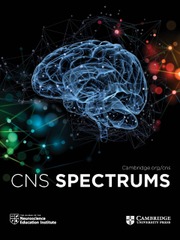Take-Home Points
-
1. Orexin is a peptide neurotransmitter, also called hypocretin.
-
2. There are 2 orexins, A and B, and 2 receptors, orexin 1 and orexin 2.
-
3. Orexins maintain arousal in response to various stimuli, leading to the attainment of reward by facilitating goal-directed, motivated behaviors.
-
4. Suvorexant blocks both orexin receptors, and hypothetically no longer allows orexins to sustain wakefulness nor to increase arousal in motivating conditions, thus acting as a sleep-promoting hypnotic agent without causing rebound insomnia or risk of dependence.
Orexin neurons are localized exclusively in certain hypothalamic areas (lateral hypothalamic area, perifornical area, and posterior hypothalamus) (Figure 1).Reference Stahl 1 – Reference España and Scammell 3 These orexin neurons make the neurotransmitters orexin A and orexin B, which are released from their neuronal projections all over the brain, but especially in the monoamine neurotransmitter centers in the brainstem (Figure 1).Reference Stahl 1 – Reference España and Scammell 3 The postsynaptic actions of the orexins are mediated by 2 receptors, called orexin 1 and orexin 2 (Figure 2).Reference Stahl 1 – Reference España and Scammell 3 The neurotransmitter orexin A interacts with both orexin 1 and 2 receptors, but orexin B interacts only with orexin 2 receptors (Figure 2).Reference Stahl 1 – Reference España and Scammell 3 Notably, orexin 1 receptors are particularly high in the brainstem locus coeruleus, site of noradrenergic neurons; orexin 2 receptors are highly expressed in the tuberomammillary nucleus (TMN), site of histamine neurons. It is believed that the effect of orexin on wakefulness is largely mediated by activation of the TMN histaminergic neurons that express orexin 2 receptors.Reference Stahl 1 – Reference España and Scammell 3 Presumably, orexin 2 receptors therefore play a pivotal role, with orexin 1 receptors having an additional role in sleep–wake regulation. Orexins mediate various motivated behaviors in addition to wakefulness and vigilance, such as eating and reward, perhaps particularly through orexin 1 receptors (Figure 3).Reference Stahl 1 – Reference Nixon, Mavanji, Butterick, Billington, Kotz and Teske 7

Figure 1 Orexin projections from the hypothalamus are shown here. The neurotransmitter orexin (also called hypocretin) is made by cells located in the hypothalamus, specifically in the lateral hypothalamic area (LHA) and the perifornical and posterior hypothalamus (PH). Orexin A and orexin B produced by these cells are released at various brain areas, including monoamine neurotransmitter centers in the hypothalamic tuberomammillary nucleus (TMN; for histamine) and in the brainstem such as the ventral tegmental area (VTA; for dopamine), the locus coeruleus (LC; for norepinephrine), the pedunculopontine tegmental and laterodorsal tegmental nuclei (PPT/LDT; for acetylcholine), and raphe nucleus (for serotonin).

Figure 2 Hypocretin/orexin neurotransmission is mediated by 2 types of postsynaptic G-protein-coupled receptors, orexin 1 (Ox1R) and orexin 2 (Ox2R). The neurotransmitter orexin A is capable of interacting with both Ox1R and Ox2R, whereas the neurotransmitter orexin B binds selectively to Ox2R. The binding of orexin A to Ox1R leads to increased intracellular calcium as well as activation of the sodium/calcium exchanger. The binding or orexin A or B to Ox2R leads to increased expression of N-methyl-D-aspartate (NMDA) glutamate receptors as well as inactivation of G-protein-regulated inwardly rectifying potassium (GIRK) channels. Ox1R’s are highly expressed in the noradrenergic locus coeruleus, whereas Ox2R’s are highly expressed in the histaminergic tuberomammillary nucleus (TMN).

Figure 3 During periods of wakefulness and partly under the control of the circadian drive from light/dark cycles, hypocretin/orexin neurons are active and fire with tonic frequency to maintain arousal. When presented with a stimulus (either external, such as an escapable stressor, or internal, such as elevated CO2 levels), hypocretin/orexin neurons exhibit a more rapid phasic burst firing pattern. This excitement of hypocretin/orexin neurons leads to increased neurotransmission and the activation of other brain areas and peripheral responses, which in turn leads to the execution of appropriate behavioral responses. These behavioral responses lead to the attainment of reward or the avoidance of potential danger. In this way, the hypcretin/orexin system not only mediates wakefulness, but also allows for the facilitation of goal-directed, motivated behaviors, including increased food intake in response to hunger.
Lack of orexins is associated with narcolepsy.Reference Stahl 1 – Reference España and Scammell 3 Reversible pharmacologic blockade of orexin receptors is now proven to be a novel hypnotic mechanism (Figure 4).Reference Stahl 1 – Reference Michelson, Snyder and Paradis 16 Other potential clinical applications, based on preclinical studies, could eventually include use for weight loss or drug abuse.Reference Stahl 1 , Reference Mahler, Moorman, Smith, James and Aston-Jones 4 , Reference Hoyer and Jacobson 6 , Reference Nixon, Mavanji, Butterick, Billington, Kotz and Teske 7 , Reference Yeoh, Campbell, James, Graham and Dayas 12 Dual orexin receptor antagonists (DORAs) that block both orexin 1 and 2 receptors, and single orexin receptor antagonists (SORA-1s and SORA-2s) that selectively block either orexin 1 receptors or orexin 2 receptors, have also been developed (Figure 4) and are being extensively tested at this time.Reference Stahl 1 – Reference España and Scammell 3

Figure 4 Stimulation of hypocretin/orexin receptors is hypothesized to sustain wakefulness and increase arousal in motivating conditions. Antagonism of OxR1’s is believed to modulate dopamine in addiction/reward centers of the brain, whereas antagonism of OxR2’s may decrease histamine activity in the hypothalamus. Suvorexant is a dual hypocretin/orexin antagonist (DORA; blocking both OxR1 and OxR2) and is the only approved agent with this mechanism as a hypnotic, which promotes sleep without causing rebound insomnia or risk of dependence.
The novel DORA suvorexant is now an approved hypnotic that improves both the initiation and maintenance of sleep in human subjects, without the side effects expected of a benzodiazepine or Z drug hypnotic, namely, dependence, withdrawal, rebound, unsteady gait, falls, confusion, amnesia, or respiratory depression.Reference Stahl 1 – Reference España and Scammell 3 , Reference Yeoh, Campbell, James, Graham and Dayas 12 – Reference Michelson, Snyder and Paradis 16






